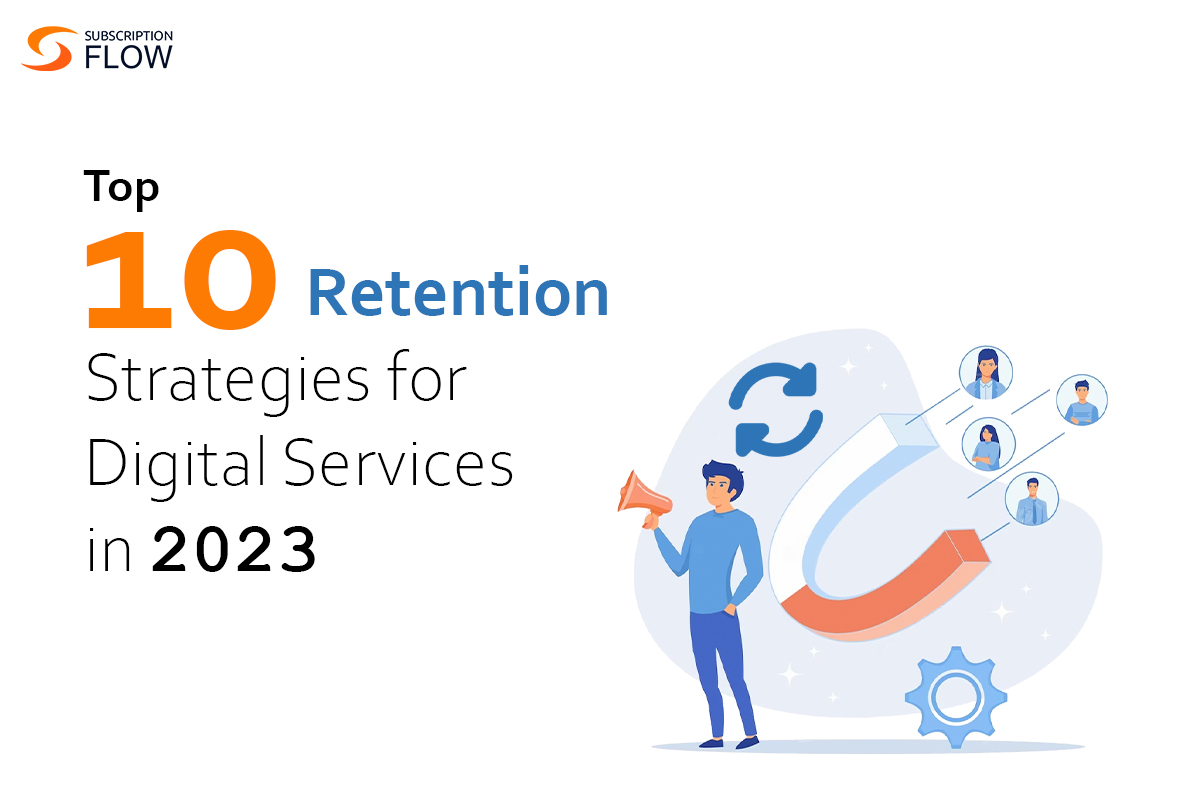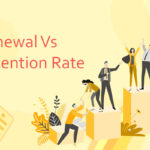
Top 10 Retention Strategies for Digital Services in 2023
Retention is challenging for digital services for several reasons. Firstly, the digital landscape is highly competitive, with countless apps, websites, and platforms vying for users’ attention. As a result, users have a vast array of choices at their fingertips, making it easy to switch to a different service if they encounter any issues or feel dissatisfied.
Moreover, digital services often cater to short attention spans, leading to a higher likelihood of users losing interest quickly. The constant influx of new content and features on other platforms can divert users away, making it difficult for digital services to retain their user base.
Secondly, user expectations are continuously evolving. As technology advances, users expect more personalized and tailored experiences. Digital services must consistently update and adapt their offerings to meet these changing demands. Please do so to avoid stagnation and eventual user attrition.
Additionally, issues with user onboarding, navigation, and user experience can significantly impact retention rates. If users find it challenging to understand or use a service, they are more likely to abandon it in favour of a more user-friendly alternative.
Therefore, retention strategies for digital services have gained increasingly support over the last few years.
Understanding Customer Retention
Customer retention occurs when a firm or product keeps its customers for an extended length of time. A brand’s clients who continue to buy its products or use its services are said to have high customer retention. In most industries, the average 8-week retention rate is less than 20%. An 8-week retention rate of more than 25% is considered for products in the media or finance industries.
You should also consider Customer Rate, which is the percentage of people who return to a brand’s products/services on a regular basis. In most industries, the average 8-week retention rate is less than 20%. An 8-week retention rate of more than 25% is regarded as desirable for products in the media or finance industries. Over 35% retention is regarded optimal in the SaaS and e-commerce businesses.
Read More: Top 10 Customer Retention Strategies for Small Businesses
Retention Strategies for Digital Services
Without any further ado, let us take a look at the top 10 strategies for customer retention for digital services
1. Personalization
Personalization involves tailoring the user experience based on individual preferences, behaviour, and demographic data. Digital services can use algorithms to analyse user data and provide content, product recommendations, or suggestions that align with each user’s interests.
For example, an e-commerce platform can show personalized product recommendations based on the user’s browsing and purchase history. In contrast, a content platform can display articles or videos relevant to the user’s past interactions.
Personalization is a powerful tool for enhancing customer retention. By tailoring products, services, and interactions to meet individual preferences and needs, businesses can create a more meaningful and engaging customer experience. When customers feel understood and valued, they are more likely to remain loyal to the brand.
The benefits of personalization include increased customer engagement and loyalty, reduced churn, and opportunities for cross-selling and upselling. Personalized experiences also lead to positive word-of-mouth and advocacy, as satisfied customers are more inclined to share their experiences with others.
Moreover, data-driven decision-making based on customer insights allows businesses to continuously improve their offerings and customer experience. In a competitive market, personalized experiences give companies a distinct edge, setting them apart from their competitors and contributing to long-term customer retention and business growth.
2. Regular Communication
Maintaining regular communication with users is crucial for keeping them engaged and informed about the latest updates and offerings. Digital services can use email campaigns, push notifications, or in-app messages to share news, promotions, and relevant content.
Regular communication is a critical factor in customer retention as it helps maintain a strong and lasting relationship between businesses and their customers. When businesses engage in consistent and meaningful communication, several benefits arise that contribute to improved customer retention.
Firstly, regular communication allows businesses to stay top-of-mind with their customers. By keeping the lines of communication open through email newsletters, social media updates, or personalized messages, customers are reminded of the brand’s presence and offerings. This constant engagement helps reinforce the customer’s connection to the brand, making them more likely to return for future purchases and remain loyal over time.
Secondly, consistent communication provides opportunities to address customer concerns and queries promptly. When customers feel heard and their issues are resolved efficiently, they develop a sense of trust and satisfaction with the brand. This positive experience contributes to improved customer loyalty and reduces the likelihood of customers switching to competitors due to unresolved problems.
Lastly, regular communication enables businesses to share relevant information, updates, and promotions with their customer base. By tailoring these messages to customer preferences and behaviour, companies can provide personalized offers and recommendations, making the customer feel valued and understood. This personalized approach enhances the overall customer experience, leading to higher levels of customer satisfaction and retention.
However, it’s essential to strike the right balance between staying in touch and avoiding overwhelming users with excessive messages.
3. Gamification
Gamification is the integration of game-like elements into the user experience to make it more engaging and enjoyable. Digital services can introduce badges for completing certain tasks, points for achieving milestones, or rewards for consistent usage.
These gamified features tap into users’ intrinsic motivations and encourage them to stay active on the platform to earn rewards or achieve recognition. When applied effectively, gamification can have a positive impact on customer retention by enhancing the overall customer experience and fostering stronger connections between customers and businesses.
Firstly, gamification adds an element of fun and excitement to the customer journey. By incorporating game mechanics like points, badges, leaderboards, and challenges, businesses can make their products or services more engaging and enjoyable. Customers are more likely to remain loyal to a brand that provides an entertaining and rewarding experience, leading to increased retention rates.
Secondly, gamification encourages repeat interactions and ongoing engagement with the brand. By offering rewards and incentives for completing certain actions or achieving specific milestones, businesses can motivate customers to return and continue using their products or services. The sense of achievement and progress created through gamification keeps customers interested and invested in the brand, leading to long-term retention.
Lastly, gamification can create a sense of community and healthy competition among customers. Leaderboards and social elements in gamified experiences allow customers to compare their progress with others and compete for recognition or rewards. This fosters a feeling of belonging and encourages customers to stay involved with the brand to maintain their position within the community, ultimately boosting customer retention.
4. Loyalty Programs
Loyalty programs are designed to reward users for their ongoing engagement and loyalty to the digital service. These programs can offer various benefits, such as exclusive access to new features, discounts, or even freebies.
By providing tangible incentives, digital services can increase user retention and foster a sense of loyalty among their customer base.
Loyalty programs are effective tools in customer retention strategies as they offer incentives and rewards to encourage repeat business and foster customer loyalty. When implemented thoughtfully, loyalty programs can provide several benefits that contribute to improved customer retention.
These programs create a sense of appreciation and value for customers. By offering rewards, discounts, or exclusive benefits to loyal customers, businesses demonstrate that they recognize and value their patrons’ continued support. This appreciation enhances the customer experience and strengthens the emotional bond between the customer and the brand, making customers more likely to return for future purchases and remain loyal over time.
Secondly, loyalty programs incentivize repeat purchases and engagement. Customers are motivated to participate in the program to earn points or rewards, which often leads to increased spending and more frequent interactions with the brand. As customers accumulate points or rewards, they develop a sense of progress and achievement, further encouraging them to continue engaging with the program and the brand.
Additionally, loyalty programs provide valuable data and insights into customer behaviour and preferences. By tracking customer interactions and purchases through the program, businesses can gain a deeper understanding of their customers.
This data-driven approach enables businesses to personalize their offerings and communication, tailoring them to individual preferences and needs, which in turn strengthens the overall customer experience and boosts retention.
Read More: Empowering the Customer – Self-Service SaaS Solutions
5. Excellent Customer Support
Prompt and helpful customer support is vital for retaining users. When users encounter issues or have questions, a responsive customer support team can address their concerns effectively, leaving them with a positive impression of the service. This can lead to higher customer satisfaction and a decreased likelihood of churn.
6. Simplified Onboarding
A smooth and intuitive onboarding process is critical to capturing and retaining new users. The initial experience with the digital service should be straightforward and showcase the value it provides.
By guiding users through the onboarding process and offering clear instructions, the service can increase the chances of users sticking around for further engagement.
Simplified onboarding processes are instrumental in customer retention as they remove barriers and friction during the initial stages of a customer’s journey. When businesses streamline their onboarding procedures, they create a positive and efficient experience for new customers, leading to several benefits that contribute to improved customer retention.
Firstly, simplified onboarding reduces the time and effort required for customers to start using a product or service. A smooth and intuitive onboarding process minimizes frustration and confusion, making customers more likely to stay engaged and continue using the product. By avoiding complex registration forms or lengthy setup processes, businesses can increase the chances of customers completing the onboarding successfully and finding value in the product or service.
Secondly, a straightforward onboarding process sets the tone for a positive customer relationship. First impressions matter, and when customers have a pleasant experience during onboarding, they are more likely to develop a favourable perception of the brand. This positive association can lead to higher customer satisfaction and loyalty, encouraging customers to stick with the brand in the long term.
7. Social Community Building
Building a social community around the digital service creates a sense of belonging among users. This can be achieved by enabling users to interact with each other, share experiences, and discuss relevant topics within the platform.
By fostering a community, users may feel more emotionally connected to the service, leading to higher retention rates.
8. A/B Testing
A/B testing, also known as split testing, is a valuable technique for improving customer retention by allowing businesses to optimize their strategies and offerings based on data-driven insights. A/B testing involves comparing two different versions of a web page, email, or marketing campaign to see which one performs better in terms of achieving a specific goal, such as increasing customer engagement or retention.
Firstly, A/B testing helps businesses identify the most effective approaches to engage and retain customers. By testing variations of content, designs, or offers, companies can pinpoint the elements that resonate best with their target audience. This data-driven approach ensures that customer retention efforts are tailored to what works best for the customers, increasing the likelihood of creating experiences that lead to higher customer satisfaction and loyalty.
Secondly, A/B testing enables continuous improvement and refinement of customer retention strategies. As customer preferences and behaviours evolve over time, businesses need to adapt their approaches accordingly. A/B testing allows companies to experiment with different ideas and quickly determine what strategies are the most successful at any given moment. This iterative process ensures that businesses can stay ahead of their competition, retain their customers, and consistently deliver valuable experiences that keep customers coming back.
9. Incentives for Referrals
Word-of-mouth marketing is a powerful tool for user retention. By offering incentives for user referrals, digital services can encourage satisfied customers to share their positive experiences with others. This not only helps acquire new users but also strengthens the existing users’ loyalty as they receive rewards for successful referrals.
10. Data Analysis
Data analytics plays a crucial role in customer retention for digital services because it helps in understanding user behaviour and identifying potential areas of improvement. Digital services can analyze user data to gain insights into churn patterns, engagement levels, and feature usage. By identifying trends and patterns, the service can proactively address issues and enhance the user experience, ultimately improving retention rates.
Read More: From Robust Reporting to Increased Efficiency—The Benefits of Automated Recurring Revenue Management
Final Word
In summary, effective user retention strategies for digital services involve understanding users’ needs, leveraging data insights, and continuously optimizing the user experience to foster loyalty and engagement with the digital service.
SubscriptionFlow is equipped with tools to help you implement the aforementioned strategies so you can decrease churn and increase customer retention. Book a demo with us to find out more.










